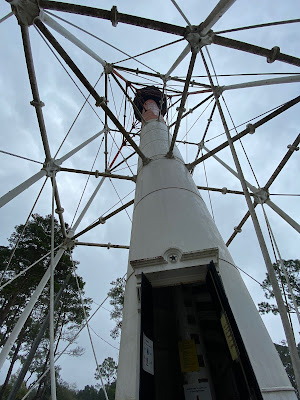 |
| Cape St George Lighthouse and Keepers House |
Cape St. George Lighthouse
The stories of Florida lighthouses often include tales about when they were rebuilt after being knocked down in a hurricane, and this one located on St. George Island is no exception. Originally built in 1833, this lighthouse collapsed and was moved inland and rebuilt 3 times before beach erosion caused the last one to fall down in October 2005. Volunteers chipped mortar off of 22,000 original 19th century bricks which were used to rebuild the current lighthouse using the original plans. This lighthouse opened to the public in 2008.
St, George Island is one of the 3 barrier islands that are part of the Forgotten Coast. The rebuilt lighthouse now stands with a replica Lighthouse Keeper House at the center of the island at the end of the bridge used to access the island. The house can be visited for free, and you can climb the lighthouse for $5.
 |
| At the base the walls are 4 feet thick |
Somewhere along the line, the cast-iron stairs that wound their way up through the center of the lighthouse got destroyed. Now, lovely wooden stairs wind their way along a central wooden post up the lighthouse. This is a unique experience for veteran lighthouse climbers. With open cast-iron stairs you can look up at where you are going and also look down at the floor of the lighthouse. On the wooden stairs, we did not experience any of the feeling you can get of floating in space with the open cast-iron stairs.
 |
| The bridge to the mainland as seen from the lighthouse. |
 |
| Looking down St. George Island |
The last part of the climb is a 9 rung ladder and a narrow opening that you squeeze your way through to get to the top. The view is magnificent, and well worth the climb.
 |
| From the historical display. This tilt was "fixed" but eventually the beach eroded and the lighthouse collapsed. |
Crooked River Lighthouse
 |
| The Crooked River Lighthouse |
On the mainland, the Crooked River Lighthouse and replica Lighthouse Keepers House are located in Carrabelle Beach, just a short bike ride from our campground. This lighthouse was originally built on another barrier island, Dog Island, which can only be reached by boat.
 |
| Keepers House |
In the 1800s, Apalachicola had prosperous shipping industries in cotton and oysters, which necessitated the need for navigational aids through the barrier islands and construction of lighthouses on St. George and Dog Islands. The lighthouse on Dog Island was destroyed three times by storms before the decision was made in 1895 to move it to the mainland and to build it from steel instead of brick.
 |
| Looking up |
 |
| The climb |
The 103-foot iron and steel structure is open to the public and you can climb it for $5. We did not climb the lighthouse, but did peer in to look up inside it.
 |
| 2-sided Fresnel Lens from the front |
 |
| And from the back |
The lighthouse had an interesting 2-sid
Camp Gordon Johnston WWII Museum
The Forgotten Coast was home to the WWII Camp Gordon Johnston US Army 4th Infantry Amphibious Training Center. Amphibious troops trained for D-Day and for landings on Pacific islands here. The beaches along the coastline and St George and Dog Islands were used for the training exercises. Life in the base was hot, buggy and generally unpleasant.
This local history museum lovingly collects and displays memorabilia
from Camp Gordon Johnston, WWII in general, and other conflicts. Many people who served at the camp have
donated uniforms, canteens, medical materials, and other artifacts to the
museum. There are some very interesting information
panels explaining the history of the camp, and a few videos. One is a fascinating newsreel from the 1940s about
the camp showing the training exercises.
Apalachicola National Estuarine Research Reserve (ANERR)
Nature Center and Hikes
The Apalachicola National Estuarine Research Reserve studies and preserves the Apalachicola estuary system. It has a lovely Nature Center and informational hikes.
The National Estuarine Research Reserve System is a network of 30 coastal sites in the US managed in partnership between NOAA and the coastal states. They study the unique plant and animal communities that live in the bodies of water where the rivers meet the sea.
The Apalachicola River is a watershed of 19,600 square miles including the Apalachicola River in Florida, and the Chattahoochee and Flint Rivers that flow into it from Georgia and Alabama.
The Nature Center focuses on teaching visitors about estuaries with bright, attractive displays and large aquarium tanks with fish and other creatures. There is a child focused hands-on specimen study area. We found the displays about the history of the area and a small display about the turpentine industry that harvested sap from local pine trees very interesting.
The boardwalk tour that we took described the dams, power plants and other man made obstructions that drops of water would encounter as they traveled along the rivers within the estuary system. The walk ends, of course, as you come through a forested area to a beach overlooking the Apalachicola Bay. Very effective and informational.
Sadly, we were so engrossed in what we were learning, we didn’t
take any photos. Sorry folks!



No comments:
Post a Comment